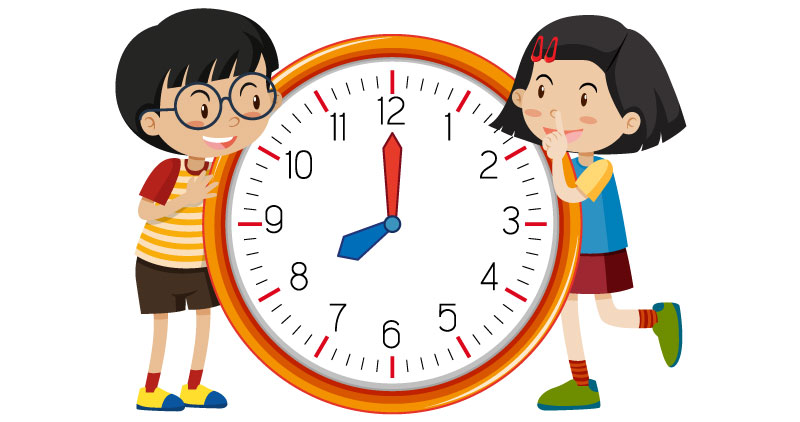Tips To Help Children Read The Clock and Tell The Time Accurately
As Sahib once said, “There’s a meaning in every tick-tock of a clock” and quoting the words of Miles Davis, “Time isn’t the main thing. It’s the only thing.” It is such a wonderful blessing to have received the gift of time but to be on-schedule, use it wisely and keep going is to have truly justified time as it is indeed precious. So, before we even begin to introduce our children to the working of a clock or a watch, they must know the importance of time, to value it and then be aware of the devices, read them, and tell the time accurately.
There are many factors related to the understanding of the clock and reading of the time. Let us look at some of the concepts below. Once children build a foundation, it will not be difficult for them to tell the time correctly.
Basic Identifications
The first identification step would be to introduce children to the kinds of gadgets. As per their age and as they start grasping things, they will learn that a clock is the one hung up on a wall or kept as a table clock and the one that is worn on the wrist is a watch. The second step is to let them realize the difference between an analog clock and a digital clock. After they have understood the basics, we can move ahead to help children recognize time.
Comfort with Numbers and Counting
Getting a grip and identifying the devices is great but the most crucial part is for the children to have a strong sense of numbers. Recognising the right digits and to declare them aptly is a must. Not only should they be familiar with the universal English digits but with Roman numerals too that are also commonly present on most clocks. Another thing is that clocks may display the time having all numbers present from English 1 to 12 or from Roman I to XII but often fancy creatively designed clocks will not have all the digits present. They may just have the English 3, 6, 9, 12 or the Roman III, VI, IX, XII. The children must not get confused with the missing digits and still be confident and announce the time. They should be taught to count 5 minutes to half hour markers to quarter past concepts. They should be capable of ascertaining the number of seconds in a minute, the number of minutes in an hour and the number of hours in a day. These are the primary number related aspects they have to conquer to tell the time precisely.

Hands of a Clock
Teach your children the difference between the small hand and the big hand of the clock which is the hour and the minutes hand respectively and the tiny hand that keeps moving continuously which is for the seconds. After they have recognized each hand and know what it denotes, then one glance at the clock and at the position of the hands, should be sufficient for children to read the time effortlessly.
Ante Meridiem and Post Meridiem
These two phenomena are vital in the world of time. Children could see the hands position on the clock and announce the time but without knowing whether it is a.m. or p.m., interpreting time and declaring it, is incomplete. An a.m. (ante meridiem) and p.m. (post meridiem) are the Latin abbreviations used to denote time. The time before midday would be a.m. and the time post midday would be p.m. In simpler terms, the hours of the night going into morning till midday would be a.m. and the hours of the day post midday going into afternoon, evening, night and then till midnight would be p.m. However, there is a general confusion when the clock strikes 12. We know as adults that 12 p.m. is afternoon time and 12 a.m. is night-time, but it takes some time for children to grasp this concept. The only way to do this is by practice. Encourage children to read the time and correct their mistakes whenever they falter. These are significant pointers that have to be ingrained in children for them to be perfect with getting to learn the clock and reading the time correctly minus any ambiguity.
The 12-hour clock and the 24-hour clock
Another key aspect of time is to teach the children the difference between the 12-hour and the 24-hour clock. The 24-hour clock is popularly referred to as military time. In the olden days, clocks showed all 24 hours, but with modern times, clockmakers invented the 12-hour clock system. If conceived properly both are simple but in general people find the 12-hour clock much easier. The 12-hour clock is from 1 a.m. to 12 noon (p.m.) and then from 1 p.m. to 12 midnight (a.m.). The 24-hour clock is from 00:00 hours (midnight) to 23:59 hours (a second to strike midnight). In a 24-hour clock there will be no a.m. or p.m. These concepts may seem complex but with practice your children will master the understanding of the clock and will cleverly and flawlessly tell the time.
The ‘Mathseeds’ programme is full of enjoyable child-focused activities that makes learning a rewarding and meaningful experience. Most school assign fun activities to children via the Mathseeds App, as an alternative to giving them boring pen-paper homework. Thus, Mathseeds has become pretty popular in India, and the Middle East, including Dubai. It is a comprehensive online mathematics programme for children aged 3-9. They offer a huge range of carefully structured lessons and activities that build mathematical skills over a broad range of number, shape, and measurement topics, irrespective of the child studying in GCC, UAE or any other part of the world. Fundamental ideas are taught in a fun, motivating and engaging way, whilst rewarding children for their efforts.






Recent Comments